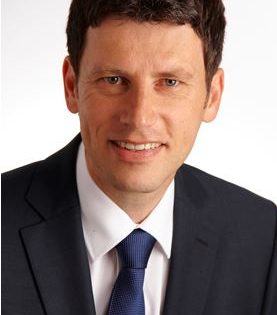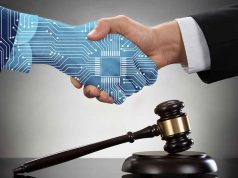Machine Learning, Blockchain, Augmented & Virtual Reality, Prescriptive Analytics, Artificial Intelligence und weitere Innovationen haben Potenzial die IT und damit die Unternehmensabläufe zu verändern. Die neuen Technologien haben – noch – nicht alle ihre Marktreife erreicht und sind als Produkte/Lösungen verfügbar, versprechen aber große Chancen für Unternehmen. Analysten, Marktforscher und IT-Experten zeigen auf, was auf IT-Verantwortliche zukommen kann.
VIELE Analysten, Marktforschungshäuser und IT-Experten gaben zum Jahres-Ende ihre Wasserstandsmeldungen und Voraussagen für das Jahr 2017 ab. Wenngleich diese auch unterschiedliche Trends vermelden, zeichnet sich doch auch eine große Schnittmenge unter den prognostizierten Technologien ab. Im Folgenden erhalten IT-Manager eine Übersicht der Vorhersagen, die jeweils zu ausführlichen Beschreibungen verlinken:
 Mark van Rijmenam is Founder of Datafloq. Currently, he also pursues a PhD at University of Technology, Sydney on how organizations should deal with Big Data, the Blockchain and Algorithms.
Mark van Rijmenam is Founder of Datafloq. Currently, he also pursues a PhD at University of Technology, Sydney on how organizations should deal with Big Data, the Blockchain and Algorithms.
Ausführungen zu den folgenden Trends von Mark van Rijmenam lesen Sie unter diesem Link
1. Blockchain-enabled Smart Contracts: Blockchain 2.0
2. Deep Learning Becomes Smarter and Brings Us Closer to Artificial General Intelligence
3. Conversational AI: Intelligent Applications Will Revolutionise Interactions
4. IoT-Related Data Breaches Will Cause Havoc
5. Mixed Reality Will Drastically Improve Data Visualisations and Decision-Making
6. Big-Data-as-a-Self-Service Solutions Will Catalyse Big Data Adoption
7. Sensemaking through Mixed Data Will Empower Employees
2017: The Year of Intelligence
 Arnold Vogt ist als Senior Advisor bei der Experton Group tätig.
Arnold Vogt ist als Senior Advisor bei der Experton Group tätig.
Herr Vogt berät ICT-Anbieter- und -Anwender in aktuellen IT-Servicethemen wie Cloud Computing und Industrie 4.0 (Internet der Dinge & Dienste).
Trend #1: Industry 4.0 / IoT “killer apps”
Trend #2: Power to the Industry 4.0 / IoT user
Trend #3: Standardized Industry 4.0 / IoT complete solutions
Trend #4: Industry 4.0 manufacturing
Trend #5: IoT platforms
Trend #6: Industry 4.0 / IoT data integration and big data/analytics
Trend #7: Users become Industry 4.0 / IoT vendors
Trend #8: IoT Ecosystems
 Louis Columbus is Vice President, Worldwide Marketing at iBASEt. Previous positions include product marketing at Plex Systems, senior analyst at AMR Research (now Gartner).
Louis Columbus is Vice President, Worldwide Marketing at iBASEt. Previous positions include product marketing at Plex Systems, senior analyst at AMR Research (now Gartner).
Ausführungen von Louis Columbus zu den folgenden Trends von lesen Sie unter diesem Link
Top 10 Ways Integration Will Transform Manufacturing In 2017
- Real-time visibility across selling, pricing, product, manufacturing and service improves the speed of customer response and makes planning easier.
- Making analytics the fuel manufacturing needs to move faster, attaining time-to-market goals and exceeding customer expectations.
- Improving new product success rates by integrating CRM, pricing, product catalog, service, and Product Lifecycle Management (PLM) systems are enabling manufacturers to create new product lines that drive new business models.
- Configure-Price-Quote (CPQ) will continue to be one of the most effective strategies manufacturers can use for accelerating sales in 2017, made possible by the real-time integration between ERP, CRM, pricing and manufacturing systems.
- Industry 4.0’s many advantages including creating smart factories are dependent on the real-time integration of traditional IT and manufacturing systems increasing production speed and quality.
- Personalizing pricing strategies by customer persona and segment using real-time integration between CRM, pricing, accounting and finance systems to optimize profitability.
- IT system security companywide improves with tighter real-time integration as long-standing legacy systems are updated to enable greater connectivity with newer systems.
- Sensor data generated from the Internet of Things (IoT) combined with advanced analytics is transforming manufacturing today and will accelerate in 2017.
- Market leaders in manufacturing are designing in real-time integration to their connected products, enabling new sources of revenue.
- Greater visibility and speed are coming to supply chains, enabling manufacturers the ability to take an accepted quote and turn it into build instructions in real-time.
Brian Hopkins , VP at Forrester, Principal Analyst serving Enterprise Architecture Proffessionals
, VP at Forrester, Principal Analyst serving Enterprise Architecture Proffessionals
Ausführungen zu den folgenden Trends von Brian Hopkins lesen Sie unter diesem Link
- IoT software and solutions bring customer engagement potential within reach.
- Intelligent agents coupled with AI/cogntive technologies will automate engagement and solve tasks.
- Augmented reality overlays digital information and experiences on the physical world using combinations of cameras and displays.
- Hybrid wireless technology will eventually ereate connected everything.
 Lynn Thorenz ist Director Research & Consulting, IDC Deutschland und Schweiz.
Lynn Thorenz ist Director Research & Consulting, IDC Deutschland und Schweiz.
Ausführungen zu den folgenden Trends von Lynn Thorenz lesen Sie unter diesem Link.
1. Digitale Transformation
2. Von Cloud-First zu Cloud-Only
3. Daten und Plattformen
4. Cognitive Systems
5. Industry Collaborative Clouds
6. NextGen Security – „Detect and Respond“ statt „Prevent and Protect“
 Tony Baer leads Ovum’s Big Data research area. His coverage focuses on how Big Data must become a first-class citizen in the data center, IT organization, and the business.
Tony Baer leads Ovum’s Big Data research area. His coverage focuses on how Big Data must become a first-class citizen in the data center, IT organization, and the business.
1) Machine learning will be the biggest disruptor for big data analytics in 2017.
2) Making data science a team sport will become a top priority.
3) IoT use cases will push real-time streaming analytics to the front burner.
4) The cloud will sharpen Hadoop-Spark “co-opetition.”
5) Security and data preparation will drive data lake governance.
Maximilian Hille ist Analyst und Mobile Practice Lead des IT-Research- und Beratungsunternehmens Crisp Research AG.
ist Analyst und Mobile Practice Lead des IT-Research- und Beratungsunternehmens Crisp Research AG.
1. Mobile Personal Assistants & Bots
2. Virtual & Augmented Reality
3. Smart Field Services
4. Unified Digital Workplaces
5. Coworking & Innovation Hot Spots
 Yaron Haviv, Hands-on expert, Blogger and Visionary in Storage, Networking, #BigData & #Cloud, VP & CTO background,
Yaron Haviv, Hands-on expert, Blogger and Visionary in Storage, Networking, #BigData & #Cloud, VP & CTO background,
Ausführungen zu den folgenden Trends von Yaron Haviv lesen Sie unter diesem Link
- Rapid Growth of Enterprise Cloud Adoption
- The Cloud of Musical Chairs
- Growth of Public Cloud Providers
- Order in the House of Containers
- Big Data beyond Hadoop

Chris Kocher is a co-founder of Grey Heron, a management and strategic marketing consulting firm.
Ausführungen zu den folgenden Trends von Chris Kocher lesen Sie unter diesem Link.
1. Ecosystems begin to determine winners and losers
2. Vendors get serious about experimenting with business models and monetization
3. Big Data gets “cloudier” (pun intended)
4. You’ll need to prove your security, with privacy not far behind
5. Voice-powered, AI virtual assistants drive a next round of platform wars
 Klaus-Michael Vogelberg, Chief Technology Officer beim Softwareanbieter Sage
Klaus-Michael Vogelberg, Chief Technology Officer beim Softwareanbieter Sage
Ausführungen zu den folgenden Trends von Klaus-Michael Vogelberg lesen Sie unter diesem Link.
Trend 1: Chatbots und autonome Anwenderschnittstellen
Trend 2: Künstliche Intelligenz und Schwarmintelligenz
Trend 3: Blockchain oder wie man im digitalen Zeitalter Vertrauen schafft
Trend 4: Revolutionierung von Finanztransaktionen
Trend 5: Plattform-basierte Infrastruktur
Trend 6: Das Internet of Things (IoT) wird neue Dienstleistungen und Jobs schaffen
 Dr. Friedrich Neumeyer ist CEO der proALPHA Gruppe
Dr. Friedrich Neumeyer ist CEO der proALPHA Gruppe
1. Cloud-Lösungen verändern IT-Landschaft nachhaltig
2. ERP ist das Rückgrat für die digitale Transformation
3. Mobile Anwendungen spielen im industriellen Umfeld eine wichtigere Rolle
4. Dokumenten-Management wird zum integrierten Teil von ERP-Lösungen
5. Mit Business Intelligence im ERP auch große Datenmengen analysieren
6. Die Integration von CRM und ERP schreitet weiter voran
7. Das Internet der Dinge stellt neue Anforderungen an das ERP
8. Anbindung von Lieferanten und Kunden über ein Web-Portal

David Cearley is a Vice President and Gartner Fellow in Gartner Research
Ausführungen zu den folgenden Trends von David Cearley lesen Sie unter diesem Link
Trend No. 1: AI & Advanced Machine Learning
Trend No. 2: Intelligent Apps
Trend No. 3: Intelligent Things
Trend No. 4: Virtual & Augmented Reality
Trend No. 5: Digital Twin
Trend No. 6: Blockchain
Trend No. 7: Conversational Systems
Trend No. 8: Mesh App and Service Architecture
Trend No. 9: Digital Technology Platforms
Trend No. 10: Adaptive Security Architecture
Anzeige
Digital Transformation: Prozesse und Software richtig verzahnen – Trovarit
Die erfahrenen Trovarit Berater unterstützen Ihr Unternehmen umfassend bei der Auswahl und Einführung von Geschäfts-Software aber auch als Trusted Advisor bei der Optimierung der gesamten IT-Strategie oder der Analyse und Verbessserung von Geschäftsprozessen.
Beratungsdienstleistungen der Trovarit
- Potenzialanalyse-/Prozessanalyse
- Lastenhefterstellung
- Marktrecherche und Ausschreibung
- Drehbücher für strukturierte Anbieterpräsentationen
- Moderation von Anbieterpräsenationen
- Vertragsprüfung & -verhandlung
- Projekteinrichtung (Projektmanagement, Projekt-Controlling, Projekthandbuch)
- Projekt-Coaching/-Leitung während der Implementierung
- Projektreview / Projekt-Audit
- Projektabnahme
- Analyse und Optimierung des ERP-Systemeinsatzes (ERP-Audit)
- Analyse und Optimierung der IT-Infrastruktur (IT-Infrastruktur-Audit)



